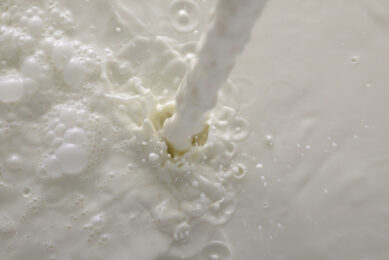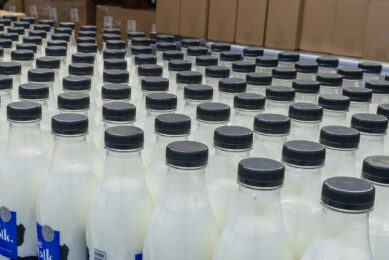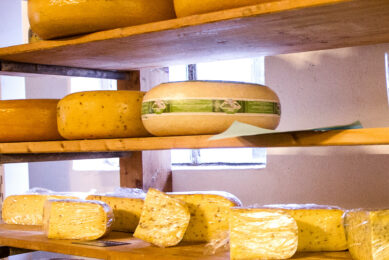Rising production costs will keep dairy farm margins tight

The rising cost of production at farm level will keep margins of dairy farms tight, limiting milk production growth, Rabobank expects.
Rabobank recently released its annual Global Dairy Top 20 report. It shows that the combined turnover of the top 20 industry leaders fell by just 0.1% in US dollar terms, following the prior year’s 1.8% gain. In 2021, privately held Lactalis unseated long-time industry titan, Nestlé, as the world’s largest dairy company, according to Mary Ledman, global dairy strategist for Rabobank.
“Lactalis’s attention to organic growth, as well as its dedicated global mergers and acquisitions strategy, propelled the company from 9th place in 2000 to a dominating lead position in 2021,” Ledman says.
Limited milk production growth
Rabobank anticipates that at farm level, the rising cost of production – due to drought-induced higher feed costs and inflationary pressures – will keep margins tight, limiting milk production growth in the Big-7 exporting regions to less than 1.2%.
Over the next decade and beyond, Rabobank expects changing demographics will drive dairy opportunities.
Changing demographics
Over the next decade and beyond, Rabobank expects changing demographics will drive dairy opportunities. Over 35% of population growth will occur in Africa, which remains a net – and growing – dairy importer, largely importing from international players in the Global Dairy Top 20. Still, there will be pockets of flourishing regional domestic production growth.
China dominates imports
Rabobank says that China will continue to reign as the world’s largest dairy importer. Rather than being dominated by the infant nutrition market of the past 2 decades, China’s dairy sector will find growth in the ‘Active Silvers’ market (people over the age of 50), according to Rabobank. “The US and EU-27 markets are expected to be ageing and affluent, attracting innovation and competition.”
Read more about the dairy sector in China
In this section, we consider the 7 secrets of high-yielding dairy cows in China where big scale dairy farming is a big trend, and also, how did 2 Chinese dairy firms rank in the top 10?
For more articles on the Chinese dairy sector, click here.
Ledman concludes that natural dairy’s nutrient density will keep it a dietary staple. “But it is also imperative that the dairy sector be part of a global carbon-reduction solution that resonates with climate-sensitive consumers and prevents food manufacturers and foodservice operations from taking natural dairy out of their products and off their menus.”
New Zealand remains resilient
New Zealand’s Fonterra stayed in 6th place in Rabobank’s Top 20. Senior agri economist, Nathan Penny of Westpac, expects that the dairy sector in New Zealand will show its resilience in the current lockdown. “But that’s not to say that there won’t be any impact,” Penny emphasises. “We might see that some farm goods might be hard to come by. Supply chains are already very tight.”
Penny says that recent weakening of the NZ dollar against the US dollar will have a positive impact. “That will boost farmgate prices,” Penny says. “And many of our export markets are opening up our economies as vaccination rates improve.”
OVERVIEW: Global dairy market prices
Here you can find an overview of prices for raw milk, dry whey, skimmed milk powder, cheese and butter. Stay up-to-date…
The Global Dairy Trade auction rose by 0.3% to US$3,827 a tonne on 17 August. Of the 6 commodity indexes, 4 lifted. Butter was up 4%, cheese 2.8%, anhydrous milk fat 1.5% and skim milk powder 1.1%. The key whole milk powder index was down 1.5%.
Prices are strong
Penny points out that prices are still strong. “Stepping back from the short-term price and production fluctuations, we see the global dairy market as being largely balanced at this point,” he says. On that basis, Westpac sticks with its US$5.43 per kg milk solids. Penny: “At the same time, we continue to note that it’s early in the season and there remains a wide range of possible milk price outcomes on both sides of this figure.”
Australian dairy giant profit up 24%
In Australia, dairy giant Bega Cheese reached a sales revenue of over US$1.46 billion last financial year. The company’s profit rose 24% to US$29 million after tax. Its pre-tax earnings jumped 38% to US$103.6 million. Bega Cheese says much of its profit comes from the US$386 million acquisition of Lion Dairy and Drinks.
Join 13,000+ subscribers
Subscribe to our newsletter to stay updated about all the need-to-know content in the dairy sector, two times a week.










